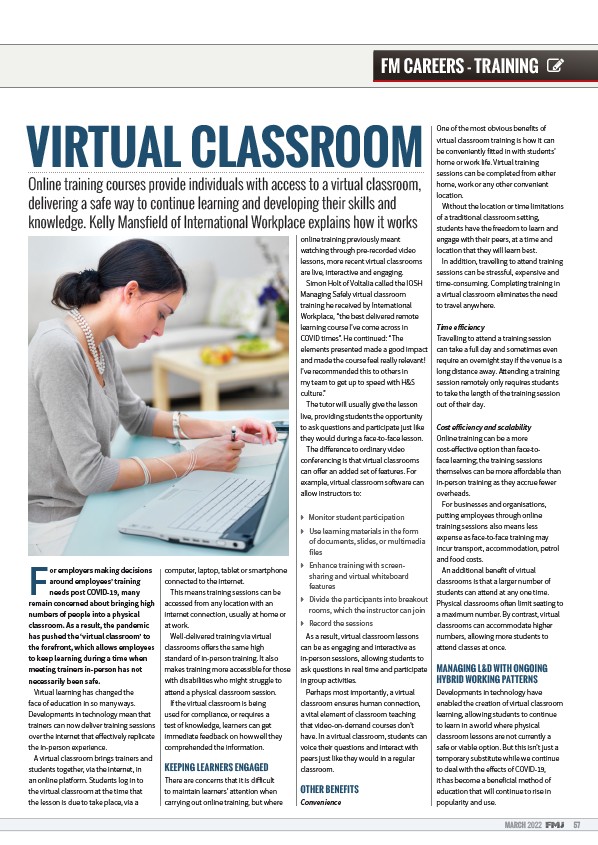
FM CAREERS - TRAINING
MARCH 2022 57
For employers making decisions
around employees’ training
needs post COVID-19, many
remain concerned about bringing high
numbers of people into a physical
classroom. As a result, the pandemic
has pushed the ‘virtual classroom’ to
the forefront, which allows employees
to keep learning during a time when
meeting trainers in-person has not
necessarily been safe.
Virtual learning has changed the
face of education in so many ways.
Developments in technology mean that
trainers can now deliver training sessions
over the internet that e ectively replicate
the in-person experience.
A virtual classroom brings trainers and
students together, via the internet, in
an online platform. Students log in to
the virtual classroom at the time that
the lesson is due to take place, via a
computer, laptop, tablet or smartphone
connected to the internet.
This means training sessions can be
accessed from any location with an
internet connection, usually at home or
at work.
Well-delivered training via virtual
classrooms o ers the same high
standard of in-person training. It also
makes training more accessible for those
with disabilities who might struggle to
attend a physical classroom session.
If the virtual classroom is being
used for compliance, or requires a
test of knowledge, learners can get
immediate feedback on how well they
comprehended the information.
KEEPING LEARNERS ENGAGED
There are concerns that it is di icult
to maintain learners’ attention when
carrying out online training, but where
online training previously meant
watching through pre-recorded video
lessons, more recent virtual classrooms
are live, interactive and engaging.
Simon Holt of Voltalia called the IOSH
Managing Safely virtual classroom
training he received by International
Workplace, “the best delivered remote
learning course I’ve come across in
COVID times”. He continued: “The
elements presented made a good impact
and made the course feel really relevant!
I’ve recommended this to others in
my team to get up to speed with H&S
culture.”
The tutor will usually give the lesson
live, providing students the opportunity
to ask questions and participate just like
they would during a face-to-face lesson.
The di erence to ordinary video
conferencing is that virtual classrooms
can o er an added set of features. For
example, virtual classroom soŠ ware can
allow instructors to:
Monitor student participation
Use learning materials in the form
of documents, slides, or multimedia
files
Enhance training with screensharing
and virtual whiteboard
features
Divide the participants into breakout
rooms, which the instructor can join
Record the sessions
As a result, virtual classroom lessons
can be as engaging and interactive as
in-person sessions, allowing students to
ask questions in real time and participate
in group activities.
Perhaps most importantly, a virtual
classroom ensures human connection,
a vital element of classroom teaching
that video-on-demand courses don’t
have. In a virtual classroom, students can
voice their questions and interact with
peers just like they would in a regular
classroom.
OTHER BENEFITS
Convenience
One of the most obvious benefits of
virtual classroom training is how it can
be conveniently fitted in with students’
home or work life. Virtual training
sessions can be completed from either
home, work or any other convenient
location.
Without the location or time limitations
of a traditional classroom setting,
students have the freedom to learn and
engage with their peers, at a time and
location that they will learn best.
In addition, travelling to attend training
sessions can be stressful, expensive and
time-consuming. Completing training in
a virtual classroom eliminates the need
to travel anywhere.
Time e iciency
Travelling to attend a training session
can take a full day and sometimes even
require an overnight stay if the venue is a
long distance away. Attending a training
session remotely only requires students
to take the length of the training session
out of their day.
Cost e iciency and scalability
Online training can be a more
cost-e ective option than face-toface
learning; the training sessions
themselves can be more a ordable than
in-person training as they accrue fewer
overheads.
For businesses and organisations,
putting employees through online
training sessions also means less
expense as face-to-face training may
incur transport, accommodation, petrol
and food costs.
An additional benefit of virtual
classrooms is that a larger number of
students can attend at any one time.
Physical classrooms oŠ en limit seating to
a maximum number. By contrast, virtual
classrooms can accommodate higher
numbers, allowing more students to
attend classes at once.
MANAGING L&D WITH ONGOING
HYBRID WORKING PATTERNS
Developments in technology have
enabled the creation of virtual classroom
learning, allowing students to continue
to learn in a world where physical
classroom lessons are not currently a
safe or viable option. But this isn’t just a
temporary substitute while we continue
to deal with the e ects of COVID-19,
it has become a beneficial method of
education that will continue to rise in
popularity and use.
VIRTUAL CLASSROOM
Online training courses provide individuals with access to a virtual classroom,
delivering a safe way to continue learning and developing their skills and
knowledge. Kelly Mansfi eld of International Workplace explains how it works